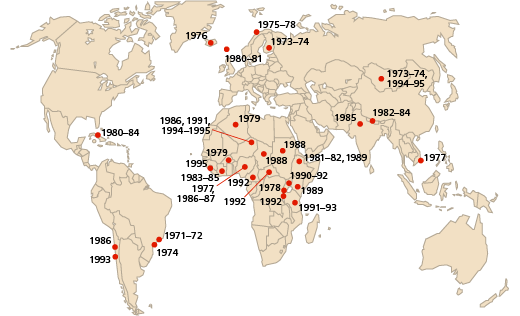Meningococcal disease (Neisseria meningitidis)
Even with appropriate treatment, the disease can be fatal or result in permanent disability
Neisseria meningitidis (meningococcus) is an important cause of contagious bacterial meningitis that can lead to life-threatening infections in infants, children, and young adults.
Clinical presentation
The most common clinical presentation is acute meningitis, which is characterized by fever and chills, intense headache, stiff neck, vomiting, lethargy or drowsiness, or signs of irritability. These symptoms can develop within several hours or may take one or two days to appear, but they should always be treated as a medical emergency. Less commonly, patients present with meningococcal septicaemia, a catastrophic constellation of fever, purpuric rash, multiorgan failure, and shock of frighteningly rapid onset. Meningococcal septicaemia is fatal in most cases.
Diagnosis
Meningococcal meningitis is usually diagnosed by analyzing a sample of cerebrospinal fluid obtained through lumbar puncture—a technique that involves inserting a needle into the lower spine between lumbar vertebrae L4 and L5 to obtain a sample of cerebrospinal fluid. If the diagnosis is confirmed, the patient is placed on antibiotics.
Morbidity and mortality
In the absence of treatment, the meningitis mortality rate can exceed 50 percent. Even with appropriate care:
- At least 10 percent of patients die, typically within 24–48 hours of the onset of symptoms.
- Approximately 10 to 20 percent of survivors are left with permanent aftereffects such as mental retardation, deafness, epilepsy, or other neurological disorders.
Epidemiology
At any given time 10 to 25 percent of the global population carry meningococcal bacteria in the back of their throats or in their noses, but this percentage may be much higher during an epidemic. Most carriers remain in good health and do not develop the disease. In some cases, however, bacteria overcome the body’s immune defenses, invading the body and creating an infection.
All countries suffer from endemic meningococcal disease, primarily in children under the age of five, at an annual attack rate of around 1 to 3/100,000 of the population.
Major epidemics of meningococcal disease 1971 to 1995. Source: Control of epidemic meningococcal disease, WHO practical guidelines, World Health Organization, 1998, 2nd edition, WHO/EMC/BAC/98.3 |
As this map shows, some countries, predominantly but not exclusively in the developing world, suffer from occasional or repeated epidemics of meningitis. The most prominent groups of meningococci are A, B, C, W135, and Y. While groups B and C account for a large majority of cases in Europe and the Americas, group A is responsible for explosive epidemics in the African meningitis belt and is also usually the cause of meningococcal disease in Asia.

